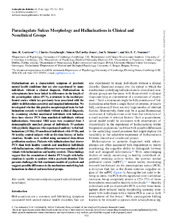| dc.contributor.author | Garrison, Jane R | |
| dc.contributor.author | Fernyhough, Charles | |
| dc.contributor.author | McCarthy-Jones, Simon | |
| dc.contributor.author | Simons, Jon S | |
| dc.contributor.author | Sommer, Iris Else Clara | |
| dc.date.accessioned | 2020-07-03T09:26:21Z | |
| dc.date.available | 2020-07-03T09:26:21Z | |
| dc.date.issued | 2019 | |
| dc.Published | Garrison, Fernyhough C, McCarthy-Jones S, Simons, Sommer IEC. Paracingulate sulcus morphology and hallucinations in clinical and nonclinical groups. Schizophrenia Bulletin. 2019;45(4):733-741 | eng |
| dc.identifier.issn | 0586-7614 | |
| dc.identifier.issn | 1745-1701 | |
| dc.identifier.uri | https://hdl.handle.net/1956/23310 | |
| dc.description.abstract | Hallucinations are a characteristic symptom of psychotic mental health conditions that are also experienced by many individuals without a clinical diagnosis. Hallucinations in schizophrenia have been linked to differences in the length of the paracingulate sulcus (PCS), a structure in the medial prefrontal cortex which has previously been associated with the ability to differentiate perceived and imagined information. We investigated whether this putative morphological basis for hallucinations extends to individuals without a clinical diagnosis, by examining whether nonclinical individuals with hallucinations have shorter PCS than nonclinical individuals without hallucinations. Structural MRI scans were examined from 3 demographically matched groups of individuals: 50 patients with psychotic diagnoses who experienced auditory verbal hallucinations (AVHs), 50 nonclinical individuals with AVHs, and 50 healthy control subjects with no life-time history of hallucinations. Results were verified using automated data-driven gyrification analyses. Patients with hallucinations had shorter PCS than both healthy controls and nonclinical individuals with hallucinations, with no difference between nonclinical individuals with hallucinations and healthy controls. These findings suggest that the association of shorter PCS length with hallucinations is specific to patients with a psychotic disorder. This presents challenges for full-continuum models of psychosis and suggests possible differences in the mechanisms underlying hallucinations in clinical and nonclinical groups. | en_US |
| dc.language.iso | eng | eng |
| dc.publisher | Oxford University Press | eng |
| dc.rights | Attribution CC BY | eng |
| dc.rights.uri | http://creativecommons.org/licenses/by/4.0/ | eng |
| dc.title | Paracingulate sulcus morphology and hallucinations in clinical and nonclinical groups | eng |
| dc.type | Peer reviewed | |
| dc.type | Journal article | |
| dc.date.updated | 2020-02-14T10:39:59Z | |
| dc.description.version | publishedVersion | |
| dc.rights.holder | Copyright 2018 The Authors | eng |
| dc.identifier.doi | https://doi.org/10.1093/schbul/sby157 | |
| dc.identifier.cristin | 1762486 | |
| dc.source.journal | Schizophrenia Bulletin | |

